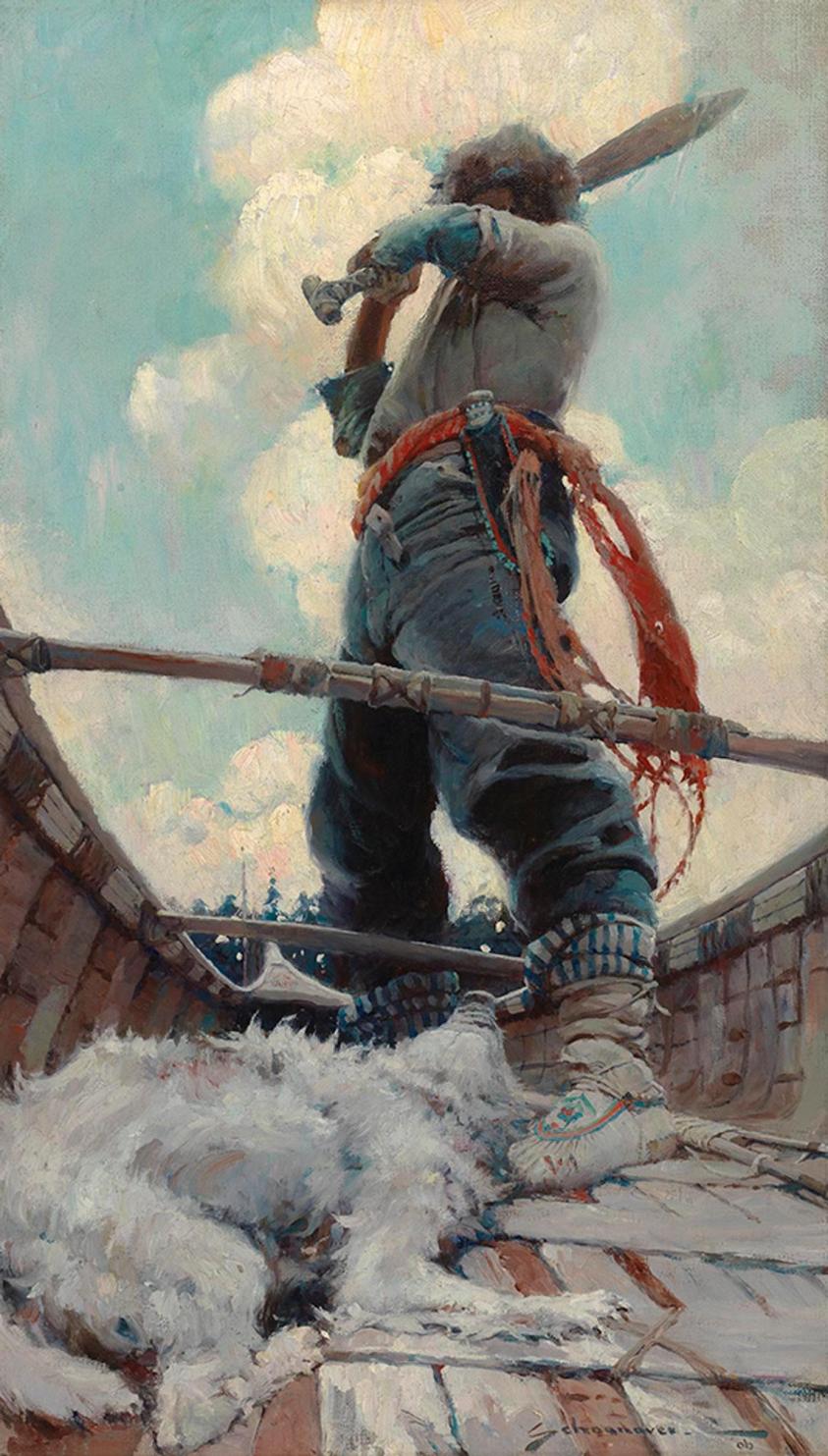
Artist:
Frank E. Schoonover
(American, 1877 - 1972)
White Fang's free nature flashed forth again, and he sank his teeth into the moccasined foot
Alternate Title(s):Canadian Trapper (White Fang and Gray Beaver in canoe)
Title (search):White Fang's free nature flashed forth again, and he sank his teeth into the moccasined foot
Medium: Oil on canvas
Date: 1906
Dimensions:
35 3/8 × 19 5/8 in. (89.9 × 49.8 cm)
Accession number: 85.10.87
Label Copy:
Howard Pyle’s student Frank E. Schoonover traveled to Canada in 1902 and became fascinated with the Canadian wilderness. Acting on Pyle’s advice to live around and be a part of his subject, Schoonover traveled on foot and by dogsled with Canadian trappers. The paintings and sketches he created from this experience would serve as reference material for illustrations for Jack London’s White Fang (serialized in Outing magazine from May through October, 1906). Like London’s story, Schoonover’s illustration takes the viewpoint of the wild dog-wolf. The severe angle of Schoonover’s composition and the tension of the figures—each poised to strike—heighten the drama of the moment.
Howard Pyle’s student Frank E. Schoonover traveled to Canada in 1902 and became fascinated with the Canadian wilderness. Acting on Pyle’s advice to live around and be a part of his subject, Schoonover traveled on foot and by dogsled with Canadian trappers. The paintings and sketches he created from this experience would serve as reference material for illustrations for Jack London’s White Fang (serialized in Outing magazine from May through October, 1906). Like London’s story, Schoonover’s illustration takes the viewpoint of the wild dog-wolf. The severe angle of Schoonover’s composition and the tension of the figures—each poised to strike—heighten the drama of the moment.
Curatorial RemarksFrank Schoonover's illustrations reflect both his interest in the outdoors and the influence of his teacher, Howard Pyle. From Pyle, Schoonover learned the importance of presenting subjects accurately. His research included travel to the Canadian North where he experienced first-hand the life of Eskimo fur traders.
An illustration for Jack London's "White Fang," "Canadian Trapper" depicts a wild dog resisting attempts to tame him. Like London's story, Schoonover's illustration describes the scene from the dog's perspective.
Frank Schoonover was one of Pyle’s students at the Drexel Institute in the final years of the nineteenth century; when Pyle moved his school to Wilmington, Delaware, Schoonover followed and eventually opened a studio of his own nearby in 1906. He traveled to Canada in 1902 while working on a story set in Montreal and became fascinated with the wilderness.
Acting on Pyle’s advice to live around and be a part of a subject, Schoonover embarked on a wilderness adventure, traveling on foot and by dogsled with Canadian trappers, painting and sketching as he went. After several other trips to Canada, he published a series of articles on his travels for Scribner’s. The paintings and sketches he created would serve as reference material for illustrations for Jack London’s White Fang (serialized in Outing magazine from May through October in 1906).
White Fang’s free nature… illustrates a scene from Jack London’s White Fang, in which the trapper tries to subdue the protagonist of the story, a wolf-like dog. Like London’s story, Schoonover’s illustration takes the unusual vantage point of the animal which, having been kicked aside by the trapper, is about to sink his teeth into the man’s foot. Schoonover’s dramatic upward perspective and the tension of the figures—each poised to strike—heighten the dramatic intensity.
An illustration for Jack London's "White Fang," "Canadian Trapper" depicts a wild dog resisting attempts to tame him. Like London's story, Schoonover's illustration describes the scene from the dog's perspective.
Frank Schoonover was one of Pyle’s students at the Drexel Institute in the final years of the nineteenth century; when Pyle moved his school to Wilmington, Delaware, Schoonover followed and eventually opened a studio of his own nearby in 1906. He traveled to Canada in 1902 while working on a story set in Montreal and became fascinated with the wilderness.
Acting on Pyle’s advice to live around and be a part of a subject, Schoonover embarked on a wilderness adventure, traveling on foot and by dogsled with Canadian trappers, painting and sketching as he went. After several other trips to Canada, he published a series of articles on his travels for Scribner’s. The paintings and sketches he created would serve as reference material for illustrations for Jack London’s White Fang (serialized in Outing magazine from May through October in 1906).
White Fang’s free nature… illustrates a scene from Jack London’s White Fang, in which the trapper tries to subdue the protagonist of the story, a wolf-like dog. Like London’s story, Schoonover’s illustration takes the unusual vantage point of the animal which, having been kicked aside by the trapper, is about to sink his teeth into the man’s foot. Schoonover’s dramatic upward perspective and the tension of the figures—each poised to strike—heighten the dramatic intensity.
On view